It looks like you're using an Ad Blocker.
Please white-list or disable AboveTopSecret.com in your ad-blocking tool.
Thank you.
Some features of ATS will be disabled while you continue to use an ad-blocker.
share:
You can add 15 multicoloured grid lines, talk of the trajectory of reflected angles and analyze contrasting proportions. It still looks exactly like a
drop of water
Originally posted by DenyObfuscation
For anyone interested, I haven't seen the actual location posted where the UO photo was taken. Looks to be about a mile north of Balos Beach Hotel.
www.panoramio.com...
I'd like to thank you for that link as it gave me a wonderful shot of that large rock/cliff.
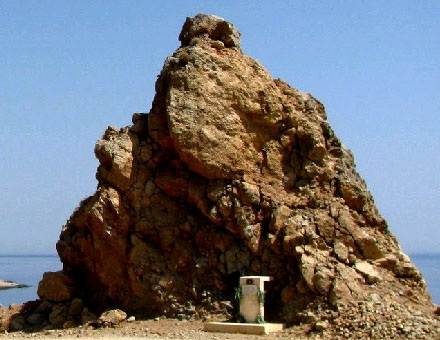
Back on page 36, free_spirit & freelance_zenarchist provided us with some video entitled: Dirty road to Balos - Crete - Greece which also has this cliff in it.
The reason why I'm interested in this shot of the rock/cliff is the structure that is there. Can someone tell me, is this a bathroom or something else like perhaps a monument? I'm hoping to get some idea of the size of this structure which might help in figuring out some scale of distance there is from it and the photographer in the car.
Triangulation might prove to be a wonderful thing for scale in this regard.. yes?
.
Johnny
**EDIT TO ADD**
Found this video that as a drive by side shot of the structure. It does appear to be that of a monument form which would be roughly a 5'x3' foot sized monument type (based on other monuments).
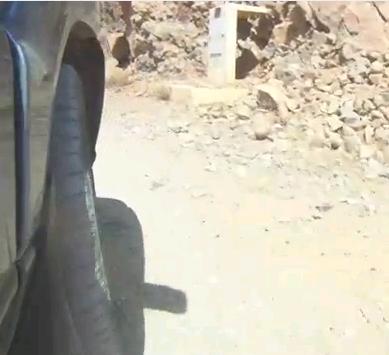
For those interested, the shot is taken at 9:21 on this video Driving to Balos beach
Here is an overlay to perhaps get us started..
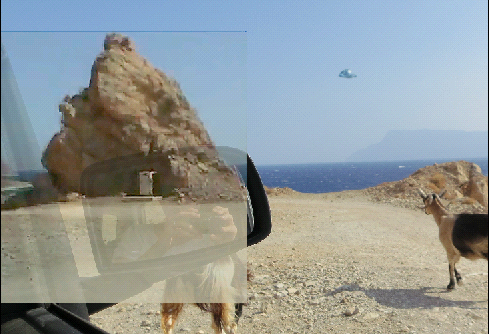
edit on 10/4/2012 by JohnnyAnonymous because: to add new pics and overlay
Originally posted by cripmeister
I can certainly imagine a family travelling to/from Balos beach and losing a ballon or throwing a plastic bag out the window. There are no practical reasons why this could not have happened.
And yes there are blue plastic bags on Crete, here is a photo showing one on Falassarna beach.
The blue color of the UFO is certainly another "red" flag. The islands of Greece generally have a blue and white color scheme, and practically everything you run into there, particularly in the touristy areas, seems to be either blue or white. For a UFO to be so conveniently Grecian blue is another indicator that it probably is of Earthly origin and not a probe from Epsilon Eridani. Everybody knows they favor pinks and oranges.
There are some features of the UFO that resemble regions of the photo - in particular, the legs of the right-most animal seem to match what is
otherwise claimed to be the tail of the "bird".
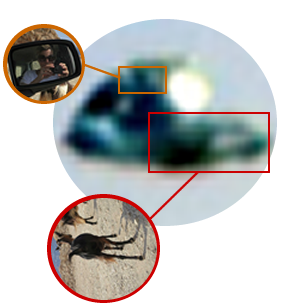
Not at all conclusive, but hopefully will promote further investigation of the reflection hypothesis.

Not at all conclusive, but hopefully will promote further investigation of the reflection hypothesis.
This is by no means accurate, it's just me eyeballing things and my best guess, but I think the UFO is too big to be a shopping bag.
I used this photo of the rock and added a picture of a blue plastic bag in front of the structure scaled to how big I think it would be.

The original, full size version is here. It's nice and large, and there's some people in the photo next to the rock that makes it easier to guess the scale.
Then I laid it over the UFO photo from the OP, and scaled it down to match the size of the rock in that photo. They're taken from different angles so I just tried to match the size, they don't line up perfectly. This is how big I believe a plastic bag at approximately the distance of the rock would be compared to the UFO.
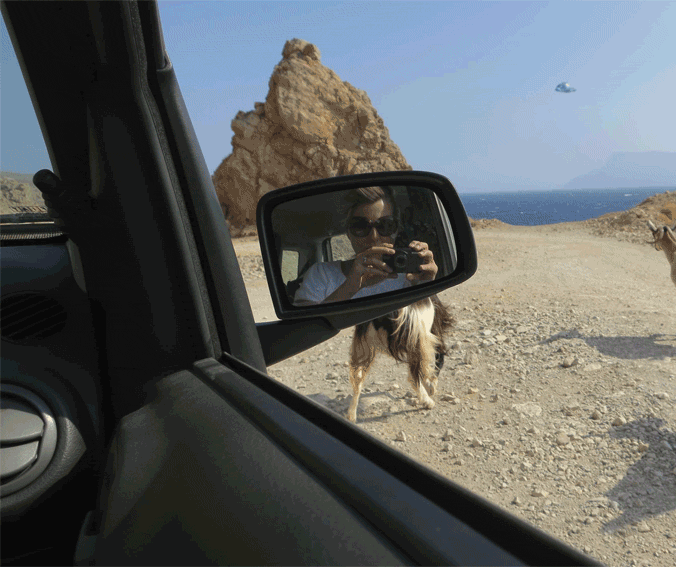
If the UFO was a bag and was farther away it would be even smaller. If it's closer than the rock then why is it so indistinguishable and bizarre looking?
I used this photo of the rock and added a picture of a blue plastic bag in front of the structure scaled to how big I think it would be.

The original, full size version is here. It's nice and large, and there's some people in the photo next to the rock that makes it easier to guess the scale.
Then I laid it over the UFO photo from the OP, and scaled it down to match the size of the rock in that photo. They're taken from different angles so I just tried to match the size, they don't line up perfectly. This is how big I believe a plastic bag at approximately the distance of the rock would be compared to the UFO.

If the UFO was a bag and was farther away it would be even smaller. If it's closer than the rock then why is it so indistinguishable and bizarre looking?
edit on 4-10-2012 by freelance_zenarchist because: changed the .jpg to a .gif to show the overlay
I have followed this thread since the beginning.
Here we are 40 plus pages later, and still nothing. The arguments are going around in circles, and it is not getting or moving this picture anywhere.
The fact is, this is NOT a balloon. Its not a plastic bag. It was something passing close to the lens.
I cannot for a second believe, that if there was a bag, a balloon, a flying tomato or anything in the sky, that not one of the two witnesses saw anything. It is very very unlikely.
This thread is now a dead horse, and it keeps on getting beaten.
vvv
Here we are 40 plus pages later, and still nothing. The arguments are going around in circles, and it is not getting or moving this picture anywhere.
The fact is, this is NOT a balloon. Its not a plastic bag. It was something passing close to the lens.
I cannot for a second believe, that if there was a bag, a balloon, a flying tomato or anything in the sky, that not one of the two witnesses saw anything. It is very very unlikely.
This thread is now a dead horse, and it keeps on getting beaten.
vvv
For comparison, here are some birds in flight:
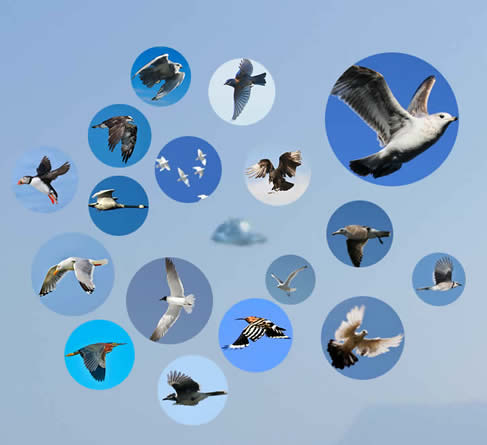
And even with some motion blur:
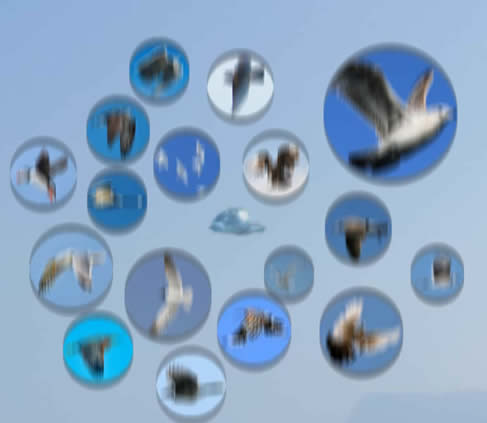
My conclusion: not a bird.

And even with some motion blur:

My conclusion: not a bird.
reply to post by VreemdeVlieendeVoorwep
It is not s dead horse
Perspective is starting to become clearer.
People are really thinking about this logically
Pretty sure the truth will be revealed soon - I think
It is not s dead horse
Perspective is starting to become clearer.
People are really thinking about this logically
Pretty sure the truth will be revealed soon - I think
Originally posted by Jinglelord
Originally posted by aynock
reply to post by Jinglelord
also, gull's wings are pointed at the end - not squareedit on 3-10-2012 by aynock because: (no reason given)
What? when did this happen?!
While it is true gull wings are pointed they can and do spread the end feathers while doing maneuvers or turning while soaring.
I may have over accentuated the squareness in my tracing but the wings aren't really in focus and the fine details aren't easy to pick out as you may have noticed. At the angle I believe the bird is in the wings would also appear more square because they don't really come to an exact point like a spear, there are flight feathers that are square that come out at an angle to the rear an out which is more or less accentuated depending on the species of gull.
in all the time i've been watching and photographing birds i've never seen a gull's wings appear square and it's plumage appear blue or reflect sunlight to appear metalic - in my experience the pose you have drawn is totally un-characteristic of gulls (or any other bird i'm aware of)
i don't understand your argument concerning flight feathers - the wing tip shape is a result of the relative lengths of the primaries - a gull's wing is pointed and always looks pointed from any angle (except straight on when it looks flat)
like i said - ask an expert
edit on 4-10-2012 by aynock because: punctuation
reply to post by aynock
It would be wonderful if we moved on from the bird theory.
Unless it an albatross it is not a bird
Even. Then an albatross is too small so it can not be a bird.
It would be wonderful if we moved on from the bird theory.
Unless it an albatross it is not a bird
Even. Then an albatross is too small so it can not be a bird.
Originally posted by salmoneggs
You can add 15 multicoloured grid lines, talk of the trajectory of reflected angles and analyze contrasting proportions. It still looks exactly like a drop of water
water droplets tend to be round - the object clearly has a flat bottom - a drop falling straight down would show some distortion to the bottom caused by air pressure but the object looks too flat to be a droplet imo
if it is fluid it is definitely falling straight down though, so it's unlikely to be from the goats
reply to post by magma
don't get me started on why it can't be an albatross
but i agree - i've made my argument as clear as i can
don't get me started on why it can't be an albatross
but i agree - i've made my argument as clear as i can
reply to post by JohnnyAnonymous
Those are monuments for someone who has died at that spot (generally approx 3ft tall).
See loads at the side of main roads around the Greek islands.
Also note the OP's 2nd image has a lanslide of that rock formation to the right, most probably been crashed into it again?
Those are monuments for someone who has died at that spot (generally approx 3ft tall).
See loads at the side of main roads around the Greek islands.
Also note the OP's 2nd image has a lanslide of that rock formation to the right, most probably been crashed into it again?
Originally posted by Druid42
Originally posted by adjensen
reply to post by Druid42
Druid, my friend, I just don't see what that anomaly could be reflecting on. The window is down, the photographer is behind the camera, so no matter what it is -- ring, sunglasses, door lock -- I don't see what it would be reflecting onto, in order for it to appear in that spot.
The anomaly isn't reflecting. It's a reflection that creates it. It's a reflection off the sunglasses.
The dark dots on the front of the image (cockpit, from some camps), are actually the two goats with black fur trotting along the car. They show up dark in the reduced reflection, in the original.
If a talented individual takes the anomaly, inverts it, and reverses it, then matches it to a zoom of the Shooter's eyeglasses, you'll be able to see the goats appear.
are you suggesting that there is an image reflecting off the sunglasses, then off the mirror into the camera lense?
it may be possible given the right shaped surfaces and alignment - the alignment would have to be incredibly precise though - and i would have thought that both sunglasses and wing mirrors would be presenting convex reflecting surfaces making the focusing of an image impossible
edit on
4-10-2012 by aynock because: (no reason given)
Ah well, my questions got ignored. Funnily enough by the very same person admonishing others for not reading *his* 'analysis'.
This sort of thread reminds me why I spend very little time here nowadays - I miss the old ATS..
But I'd like to thank all those who provided 'analyses' of the image - some were almost there, many were very entertaining. Interesting how most of them came to different conclusions.. I won't single anyone out, but I will mention that I find the 'symmetry' claims particularly hilarious.. And a few more passing comments:
1. ANY form of enlargement other than 'nearest neighbour' is showing you FALSE data. Skeptic Overlord was right on the money with his criticism of some of the ridiculous enlargements being posted here. If you don't know what 'nearest neighbour' means, or haven't heard of aliasing and interpolation, then please, STEP AWAY FROM THE IMAGE EDITOR.
2. There are VERY few methodologies that can help reveal additional real information from a digital image. Most of them do NOT involve enlargement or playing with brightness, contrast, saturation or sharpness controls. Yes, if you know what you are doing you can sometimes reveal hidden details in shadows or make some cautious inferences from comparing brightness levels or colours. You can even sometimes sharpen blurred images slightly to reveal details. But mostly, there is simply no free lunch. If you don't know what you are doing you are almost CERTAINLY going to simply magnify or enhance FALSE data, like falsely aliased detail from the enlargement techniques above, or the falsely posterised detail mentioned below, or the false halos from built-in camera sharpening / contrast enhancement... (Have you seen these issues discussed in detail by the alleged experts here?)
You cannot determine distance by brightness or supposed haze, unless you know exactly how bright or what colour the object is, in the first place. And blurring happens both in front of and behind the plane of focus - blurred objects can be either too far away or too close (or blurred from movement but that is generally easy to recognise).
3. Digital images are by nature.. digital - they 'jump' from one shade to another in discrete steps that may or may not be visible. When it comes to bright colours like the deep blue sky, and especially when using jpeg images (although this also applies to raw images, so don't kid yourself) you *will* get posterising, where the colours jump from one level to another and form false 'edges' and patterns (or blocks of 'flat' colour) that can then be enhanced into FALSE detail. And it's *not* just jpeg compressed images that have lots of false details around contrasty edges and also on 8x8 segment boundaries - raw files also suffer from sensor/amplifier induced false detail as well.
Finally, sitting there in an image editor just playing with various function sliders is the WORST possible way to analyse an image, for two reasons:
- the vast majority of such functions (like sharpening, contrast, brightness, saturation, even gamma/curves) are destructive or additive - in other ways they alter the image in ways that do NOT reveal real detail - they make the 'details' up!
- it will invariably involve the sin of confirmation bias
Confirmation bias is not a conscious thing - your brain is designed to look for patterns, so when you play around with all the functions in your editor you WILL find patterns. It's just like pareidolia, only worse because you are helping it along - adding new details that were never there in the first place..
One last tip. If someone calls themself an analyst, yet won't justify what they have done or give examples using KNOWN objects and known information to actually PROVE the efficacy of their methods, and if they don't talk about all the dangers and traps of image processing (only a few of which I've begun to outline above), then I suggest you question their credentials and supposed lack of bias. I'm very happy to back up what I've pointed out above - and it is all verifiable by doing a bit of research into real image analysis. Do the hark work of verification and *then* make up your own minds.
In the case of this image, I'm sorry folks, but there is almost NOTHING to gained by all the processing that has been thrown at it on all these pages. As for me.. I've had a reasonably close look at it, and have now lost interest. It could be a beetle, bag or bird roughly in that order. I'd like a bit more proof about the window... coz it looks an awful lot like a chip in the glass, but I accept that the window does appear to be down.
There simply isn't enough to waste time on - it's an unidentified blob. So why agonise over it further?
This sort of thread reminds me why I spend very little time here nowadays - I miss the old ATS..
But I'd like to thank all those who provided 'analyses' of the image - some were almost there, many were very entertaining. Interesting how most of them came to different conclusions.. I won't single anyone out, but I will mention that I find the 'symmetry' claims particularly hilarious.. And a few more passing comments:
1. ANY form of enlargement other than 'nearest neighbour' is showing you FALSE data. Skeptic Overlord was right on the money with his criticism of some of the ridiculous enlargements being posted here. If you don't know what 'nearest neighbour' means, or haven't heard of aliasing and interpolation, then please, STEP AWAY FROM THE IMAGE EDITOR.
2. There are VERY few methodologies that can help reveal additional real information from a digital image. Most of them do NOT involve enlargement or playing with brightness, contrast, saturation or sharpness controls. Yes, if you know what you are doing you can sometimes reveal hidden details in shadows or make some cautious inferences from comparing brightness levels or colours. You can even sometimes sharpen blurred images slightly to reveal details. But mostly, there is simply no free lunch. If you don't know what you are doing you are almost CERTAINLY going to simply magnify or enhance FALSE data, like falsely aliased detail from the enlargement techniques above, or the falsely posterised detail mentioned below, or the false halos from built-in camera sharpening / contrast enhancement... (Have you seen these issues discussed in detail by the alleged experts here?)
You cannot determine distance by brightness or supposed haze, unless you know exactly how bright or what colour the object is, in the first place. And blurring happens both in front of and behind the plane of focus - blurred objects can be either too far away or too close (or blurred from movement but that is generally easy to recognise).
3. Digital images are by nature.. digital - they 'jump' from one shade to another in discrete steps that may or may not be visible. When it comes to bright colours like the deep blue sky, and especially when using jpeg images (although this also applies to raw images, so don't kid yourself) you *will* get posterising, where the colours jump from one level to another and form false 'edges' and patterns (or blocks of 'flat' colour) that can then be enhanced into FALSE detail. And it's *not* just jpeg compressed images that have lots of false details around contrasty edges and also on 8x8 segment boundaries - raw files also suffer from sensor/amplifier induced false detail as well.
Finally, sitting there in an image editor just playing with various function sliders is the WORST possible way to analyse an image, for two reasons:
- the vast majority of such functions (like sharpening, contrast, brightness, saturation, even gamma/curves) are destructive or additive - in other ways they alter the image in ways that do NOT reveal real detail - they make the 'details' up!
- it will invariably involve the sin of confirmation bias
Confirmation bias is not a conscious thing - your brain is designed to look for patterns, so when you play around with all the functions in your editor you WILL find patterns. It's just like pareidolia, only worse because you are helping it along - adding new details that were never there in the first place..
One last tip. If someone calls themself an analyst, yet won't justify what they have done or give examples using KNOWN objects and known information to actually PROVE the efficacy of their methods, and if they don't talk about all the dangers and traps of image processing (only a few of which I've begun to outline above), then I suggest you question their credentials and supposed lack of bias. I'm very happy to back up what I've pointed out above - and it is all verifiable by doing a bit of research into real image analysis. Do the hark work of verification and *then* make up your own minds.
In the case of this image, I'm sorry folks, but there is almost NOTHING to gained by all the processing that has been thrown at it on all these pages. As for me.. I've had a reasonably close look at it, and have now lost interest. It could be a beetle, bag or bird roughly in that order. I'd like a bit more proof about the window... coz it looks an awful lot like a chip in the glass, but I accept that the window does appear to be down.
There simply isn't enough to waste time on - it's an unidentified blob. So why agonise over it further?
edit on 4-10-2012 by CHRLZ because: I mucked up some bolding and spotted a spelin erur
It looks like a chip in the passenger seat window to me.
Or a glass bubble.
Or a glass bubble.
Originally posted by DissonantOne
It looks like a chip in the passenger seat window to me.
Or a glass bubble.
Since the window is rolled down, it can't be a chip in the passenger window seat.
reply to post by freelance_zenarchist
I think you have underestimated the relative size of the plastic bag compared to the monument. I think it fits with the size of a fruit/vegetable bag (which are rather small) to the people in the photo, but they are further away down the road. I will do my best to find a photo where we can better get an idea of the size of the roadside monument, I don't think it's that big you see.
I think you have underestimated the relative size of the plastic bag compared to the monument. I think it fits with the size of a fruit/vegetable bag (which are rather small) to the people in the photo, but they are further away down the road. I will do my best to find a photo where we can better get an idea of the size of the roadside monument, I don't think it's that big you see.
reply to post by CHRLZ
You've got very good points here and I fully agree with you about the three points you raised up there, especially when you said:
We don't know what the actual colour / brightness /reflectivity of the object is, so it's impossible to determine this way if any of it's appearance is due to haze.
The only time any useful determination from something's appearance can be done is if it contains areas that are too "dark/contrasted" to be more than a given distance, given the haze effect should reduce that darkness/contrast. In this case we have the opposite - the object is very light/low contrast and we have a bright day with LOTS of ambient light so if the object is reflective/partially transparent and bright whitish blue, then it could be anywhere from right next to the lens to far off in the distance.
Let's see with examples how it works.
In a RGB photo, the Red channel is the less sensitive one to atmospheric haze.
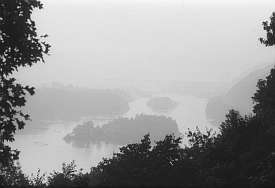
Short Wavelength (450 nm)

Long Wavelength (630 nm)
Short wavelength radiation is scattered more sharply than long wavelengths by small particles in the atmosphere. This phenomenon is known as Rayleigh scattering. When there is an increase in atmospheric particles, short wavelength scattering causes the appearance of haze. Landscape photographers traditionally use yellow or red long-wavelength filters to reduce atmospheric haze with panchromatic black-and-white films.
Let's look now closely how blue haze impact red and blue channel in some examples.
This photo, for example, exhibit blue haze at various range, depends of the distance of the mountains:
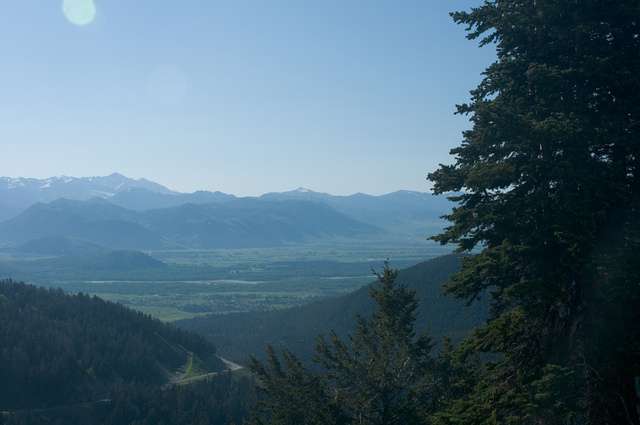
Here's now a vertical radiometric cross-section of these mountains:
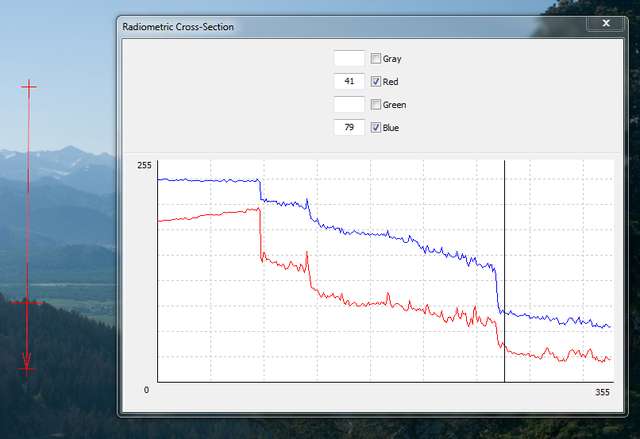
Now, see how the haze have a clear effect on both red and blue channel:
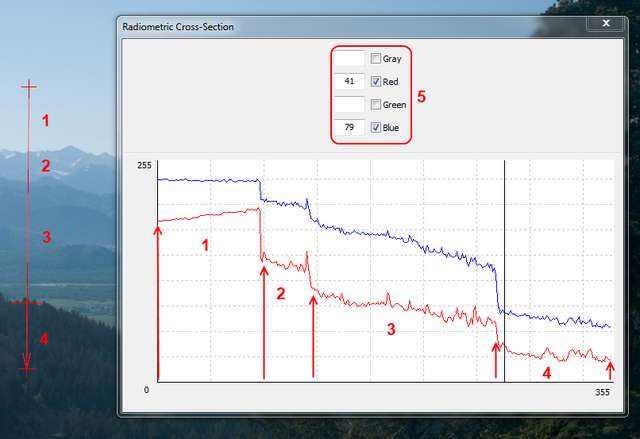
1: this is the sky part, the more the cross-section is close to the mountains, the more there are in the red channel, simply because there is a much longer path for the scattered red light to arrive to the observer (than if it comes from overhead, for example), through the lower atmosphere, which is where most of the aerosols are concentrated. The scattering effect is then magnified, causing more red light to be scattered than other any color.
2: the far away high moutains are particularly affected by blue haze. But sometimes there might be other particles in the air that are much smaller.
Some mountainous and sea regions are famous for their blue haze. Aerosols of terpenes from the vegetation react with ozone in the atmosphere to form small particles about 200 nm across, and these particles scatter the blue light. Those particles could be as well droplets from the ocean and scatter blue light as well.
The more distance there is between the subject and the observer, the more the atmosphere is thick, and the more there are blue light scattered with 200nm particles.
3: here, the curves slowly decreases as we are getting closer to the observer.
4: finally, for the closer mountains, the red channel value is around 30 and the blue around 70. Note the important slope each time we change the distance of the mountains (red arrows at the left of "2", "3" and "4")
5:note the means for the blue and the red channel (respectively 79 and 41)
Now, interestingly, the guy who've done the photo above post-processed it to correct this blue haze using the red channel correction under Photoshop:
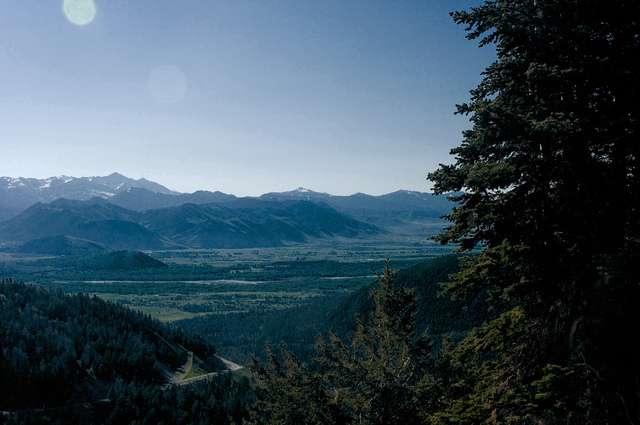
(BTW, that's what I've done in my previous post here)
So, what about our radiometric cross-section, now?
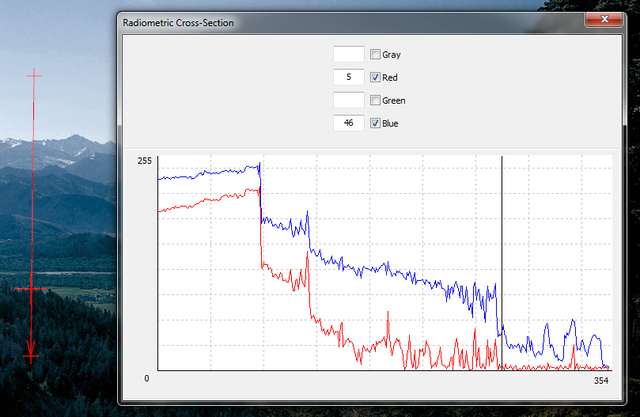
Note that the curves of the two channels have now a completely different look, with a mean for both significantly lower (46 and 5)
Anyway, is all the above could apply to our "ufo" photo?
Firstly, here's what this photo looks like under blue channel:
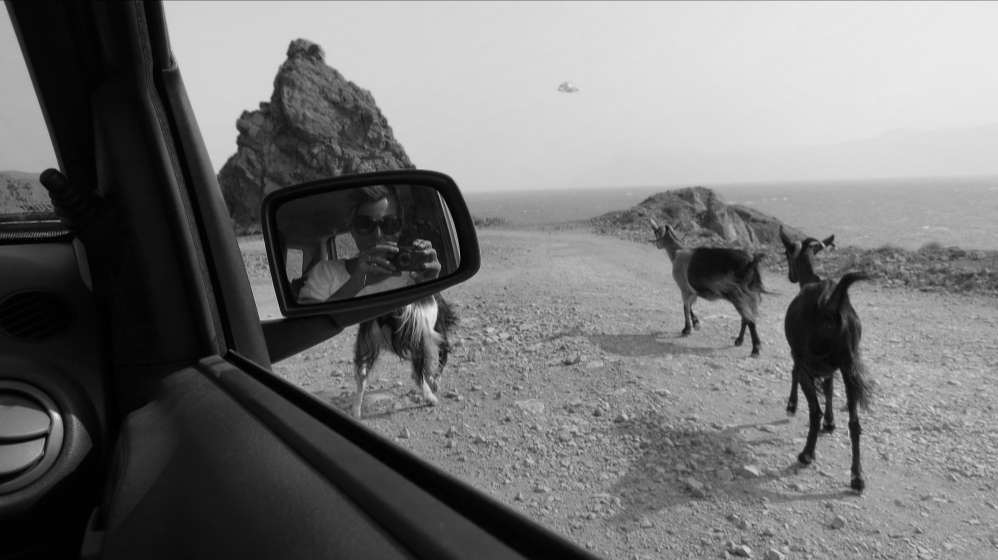
... and red channel:
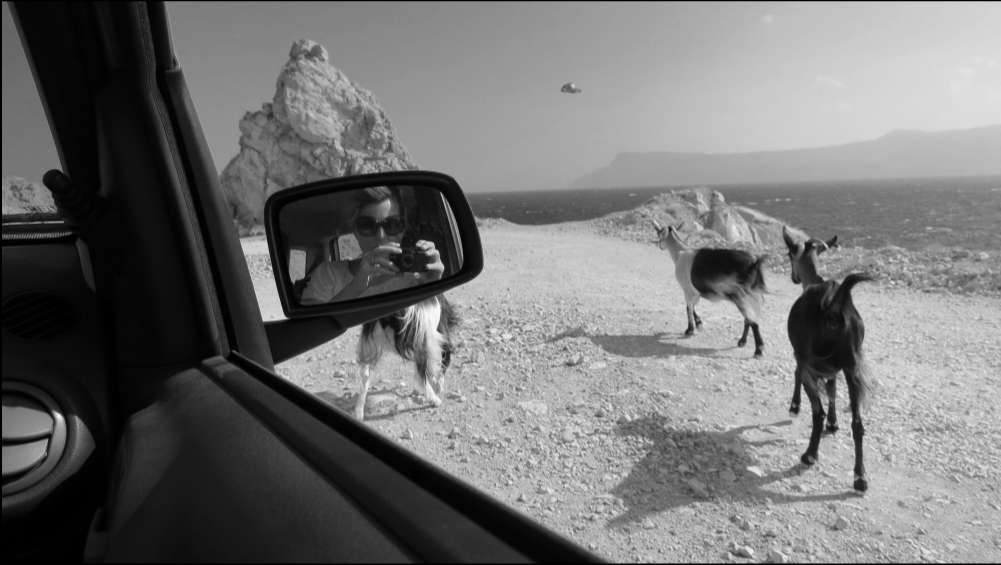
...to be continued...
You've got very good points here and I fully agree with you about the three points you raised up there, especially when you said:
You cannot determine distance by supposed haze, unless you know exactly how bright or what colour the object is, in the first place.
We don't know what the actual colour / brightness /reflectivity of the object is, so it's impossible to determine this way if any of it's appearance is due to haze.
The only time any useful determination from something's appearance can be done is if it contains areas that are too "dark/contrasted" to be more than a given distance, given the haze effect should reduce that darkness/contrast. In this case we have the opposite - the object is very light/low contrast and we have a bright day with LOTS of ambient light so if the object is reflective/partially transparent and bright whitish blue, then it could be anywhere from right next to the lens to far off in the distance.
Let's see with examples how it works.
In a RGB photo, the Red channel is the less sensitive one to atmospheric haze.

Short Wavelength (450 nm)

Long Wavelength (630 nm)
Short wavelength radiation is scattered more sharply than long wavelengths by small particles in the atmosphere. This phenomenon is known as Rayleigh scattering. When there is an increase in atmospheric particles, short wavelength scattering causes the appearance of haze. Landscape photographers traditionally use yellow or red long-wavelength filters to reduce atmospheric haze with panchromatic black-and-white films.
Let's look now closely how blue haze impact red and blue channel in some examples.
This photo, for example, exhibit blue haze at various range, depends of the distance of the mountains:

Here's now a vertical radiometric cross-section of these mountains:

Now, see how the haze have a clear effect on both red and blue channel:

1: this is the sky part, the more the cross-section is close to the mountains, the more there are in the red channel, simply because there is a much longer path for the scattered red light to arrive to the observer (than if it comes from overhead, for example), through the lower atmosphere, which is where most of the aerosols are concentrated. The scattering effect is then magnified, causing more red light to be scattered than other any color.
2: the far away high moutains are particularly affected by blue haze. But sometimes there might be other particles in the air that are much smaller.
Some mountainous and sea regions are famous for their blue haze. Aerosols of terpenes from the vegetation react with ozone in the atmosphere to form small particles about 200 nm across, and these particles scatter the blue light. Those particles could be as well droplets from the ocean and scatter blue light as well.
The more distance there is between the subject and the observer, the more the atmosphere is thick, and the more there are blue light scattered with 200nm particles.
3: here, the curves slowly decreases as we are getting closer to the observer.
4: finally, for the closer mountains, the red channel value is around 30 and the blue around 70. Note the important slope each time we change the distance of the mountains (red arrows at the left of "2", "3" and "4")
5:note the means for the blue and the red channel (respectively 79 and 41)
Now, interestingly, the guy who've done the photo above post-processed it to correct this blue haze using the red channel correction under Photoshop:

(BTW, that's what I've done in my previous post here)
So, what about our radiometric cross-section, now?

Note that the curves of the two channels have now a completely different look, with a mean for both significantly lower (46 and 5)
Anyway, is all the above could apply to our "ufo" photo?
Firstly, here's what this photo looks like under blue channel:

... and red channel:

...to be continued...
new topics
-
Potter to WHU
World Sports: 2 hours ago -
Dr. Demento
Music: 4 hours ago -
The elephant in the room (wearing a hoodie)
US Political Madness: 4 hours ago -
To become president, Zelensky had to learn Ukrainian
Political Conspiracies: 10 hours ago
top topics
-
The elephant in the room (wearing a hoodie)
US Political Madness: 4 hours ago, 7 flags -
Green Grapes
General Chit Chat: 14 hours ago, 6 flags -
To become president, Zelensky had to learn Ukrainian
Political Conspiracies: 10 hours ago, 6 flags -
Dr. Demento
Music: 4 hours ago, 2 flags -
Potter to WHU
World Sports: 2 hours ago, 1 flags
active topics
-
Los Angeles brush fires latest: 2 blazes threaten structures, prompt evacuations
Mainstream News • 132 • : alldaylong -
Russia Ukraine Update Thread - part 3
World War Three • 6907 • : ufoorbhunter -
Dr. Demento
Music • 7 • : AlroyFarms -
Mood Music Part VI
Music • 3780 • : underpass61 -
Post A Funny (T&C Friendly) Pic Part IV: The LOL awakens!
General Chit Chat • 8006 • : underpass61 -
To become president, Zelensky had to learn Ukrainian
Political Conspiracies • 16 • : DontTreadOnMe -
The elephant in the room (wearing a hoodie)
US Political Madness • 11 • : Xtrozero -
Planned Civil War In Britain May Be Triggered Soon
Social Issues and Civil Unrest • 28 • : BedevereTheWise -
My personal experiences and understanding of orbs
Aliens and UFOs • 40 • : ufoorbhunter -
Trump says ownership of Greenland 'is an absolute necessity'
Other Current Events • 67 • : xuenchen
